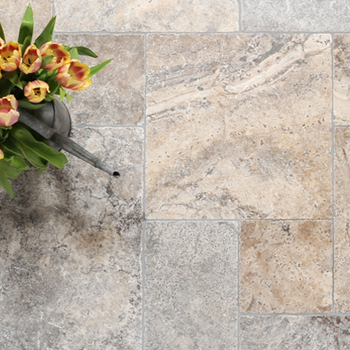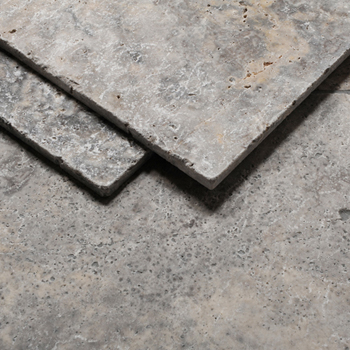Not all travertine is the same. That’s a fact! Shop around and you will find numerous websites selling travertine tiles of one description or another, but the generic nature of ‘travertine’ has made it easy for some internet retailers to sell poor travertine as ‘premium quality’.
Part of the problem is the very nature of travertine; it's impossible to compare different companies’ offerings due to its generic nature. After all, it’s not like marble tiles, where each product only comes from one source and is named accordingly: travertine comes from many different quarries, but is still just called ‘travertine’
In this article, we’ve explained what travertine flooring is, as well as the different colours, grades, and origins, to help you navigate the ins and outs of this popular type of tile.
What is travertine?
So, before we delve into the details, what are travertine tiles exactly? Travertine is a type of limestone deposited by hot mineral springs called karst. The water movement from the springs erodes the travertine, creating holes in the stone’s structure. The structure of travertine can be likened to that of a honeycomb, where small pockets or cavities exist within the stone.
The small holes are then exposed when the travertine is cut into natural stone tiles. These holes can either be left open or filled by the factory making the tiles with a cement-based filler. Occasionally, a resin filler is used, especially in polished travertine.
The main origins of travertine
We now know what travertine is, but what are the origins of each different type?
Turkey
Most travertine available in the UK (some say as much as 95%) comes from the Denizli region of Turkey. Unfortunately, only a certain number of factories in Denizli have sophisticated enough equipment to produce travertine tiles to a standard acceptable for the UK market.
However, there are numerous other areas In Turkey with travertine quarries, like the Karaman region. Travertine from this region is less known and harder to access, but generally of higher quality - we used to source a number of our travertines from this region, and they were supplied to us on an exclusive basis so are incomparable to anything else available from our competition.
Iran
Travertine also originates from other regions close to Turkey, in particular Iran. Iranian travertine used to be commonplace in the UK around fifteen years ago, but has since diminished in popularity due to various trade embargoes and the higher costs associated with procuring tiles. If you can still find Iranian travertine in the UK, though, it’s generally denser and of a higher quality than Denizili travertine.
Italy
Probably the best Travertine in the world originates from Italy. Numerous shades of cream/beige and glorious colours like red and orange are found in the Italian mountains.
Historically used in famous monuments like the colonnade of St Peter's Square in Rome, where the travertine was quarried from the famous Old Bernini quarry and ubiquitously used by the Romans for general construction, Italy has a long-standing love affair with travertino
However, as we found when we tried to introduce an Italian travertine option to our range, it's ridiculously expensive to get a medium to light beige travertino that’s similar to Turkish travertine in its appearance. If you can find it in the UK, expect to pay more than Italian marble, with prices hitting £80/sqm!
What colours go with travertine?
Travertine mainly comes in light beige and tan colours, but dark brown, chocolaty shades, and silver travertine are also available. As a rule, the darker the travertine (like dark walnut and Noce travertine), the harder the tiles. Meanwhile, wear and tear typically tends to be more obvious in lighter coloured tiles, like Ivory.
If you’re wondering what colours go with travertine, your options are relatively broad. Because the tiles are typically beige and tan, you can often get away with anything from green and blue to monochromatic whites, blacks, and greys.
The grades and different qualities of travertine
Focusing on honed and filled tiles, travertine is generally graded into three different categories:
- First choice (export quality)
- Standard choice
- Commercial choice: this is often subcategorised into C1 (aka high commercial), C2 and C3, with the latter two being the lowest quality grades.
First choice quality
Generally, first choice travertine is consistent in colour from tile to tile and uses very little filler (if any) to fill the naturally occurring holes in the surface. The overall percentage of a factory’s tile production that comes out as first choice varies, but it is usually less than 10%.
percentage of a factory’s tile production that comes out as first choice varies, but it is usually less than 10%.
This makes first choice quality travertine tiles harder to get hold of and makes them the most expensive to buy. Export quality travertine is rare in the UK due to its cost, and most of what is available is snapped up. Travertine factories have no problems in selling first choice material, so the prices are never discounted.
Standard quality
On average, 40-50% of travertine tiles are standard selection. Overall, with standard quality travertine, when compared to first choice quality, more filler is used and there can be more variation in general colour from tile to tile.
Travertine bought as standard quality is generally referred to as ‘premium quality’ in the UK market. Unfortunately, however, there are numerous people selling travertine labelled as premium quality that clearly isn’t, and so it can be difficult for customers to fully understand the difference and the implications of buying lower quality travertine.
Commercial quality
While there are generally three main quality grades in travertine (export, standard and commercial), the commercial selection is often broken down into three further grades as below:
C1 or ‘high commercial’ is the best quality
C1 is close to standard quality, though the tiles might have a bit more filler and some colour imperfections - for instance, small areas of onyx (small dark rings around where the natural holes used to be) or veining. This quality of colour is purely subjective, however: the extra colour elements in high commercial material often add to the character of the stone and can even make it more interesting.
C2 a lesser overall quality
C2 will have significantly more filler in it, and colour elements like black, red, and orange are common. This is often sold in the UK as ‘classic’ but is better categorised as eco-travertine. In terms of how much this type of travertine costs, you can find C2 variations online for £15/sqm, but you have to accept the imperfections.
C3 covers everything else
C3 is generally like C2 but with more filler and unsightly elements and covers everything that can’t be categorised as above. This is overall a poor-quality travertine and generally not fit for purpose. We wouldn’t recommend using C3 quality travertine for anything.
How to care for travertine tile flooring
Travertine tiles, especially those used on floors, require regular maintenance over the years. The honeycomb structure of travertine means that there will undoubtedly be small pockets of air just underneath the surface of the tiles, which when exposed to foot traffic can result in natural wear to the surface.
In lower quality, less dense travertine, the pockets that are exposed to wear can be larger and form craters rather than just pin holes. Part of the maintenance required for travertine floor tiles is the refilling of these pockets and pin holes on an ongoing basis.
It’s an easy job for anybody that can mix up a bit of travertine repair filler and spread it into the pit with an old credit card. You’re much less likely to need to do this with good quality travertine, though.
As with all natural stone, it’s recommended that travertine tiles are sealed with an appropriate stone sealer to help prevent liquid ingress. This is a very straight forward process that anybody can do by following the instructions on the sealer can.
If you’re wondering how to clean travertine tiles, read our guide to cleaning natural stone tiles.
So that’s about it for our guide to travertine. At Stone Superstore, we import directly from factories, negotiate reasonable prices based on volume orders, and keep our overheads low, so we can sell our products at a lower rate than anywhere else. If, however, you are unsatisfied with what you receive, we offer a full no quibble money back guarantee. Travertine has since been discontinued from our range, but this article has been left here for those of you that would like to know the facts if you are considering using this material.
Why not get in touch with our team to book an appointment with our team to discuss your tiling options, or explore even more useful insight around choosing natural stone or porcelain tiles.

